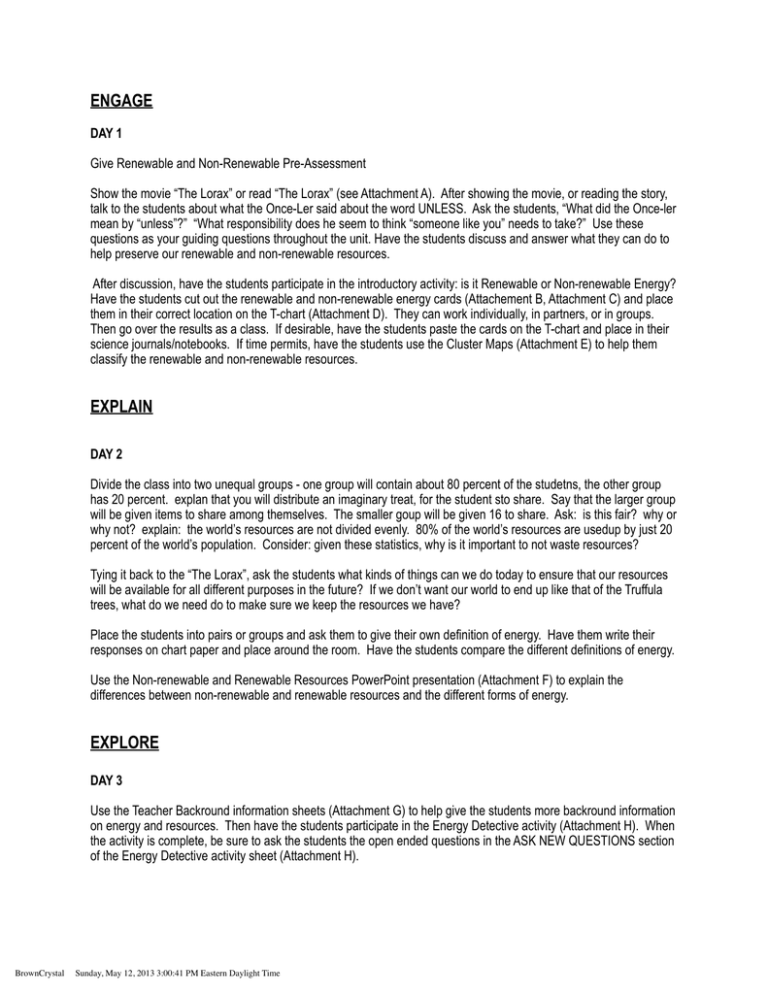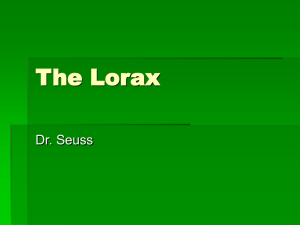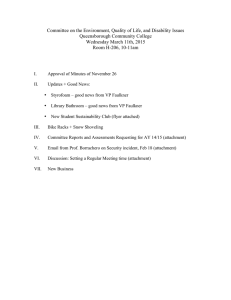ENGAGE
advertisement

ENGAGE DAY 1 Give Renewable and Non-Renewable Pre-Assessment Show the movie “The Lorax” or read “The Lorax” (see Attachment A). After showing the movie, or reading the story, talk to the students about what the Once-Ler said about the word UNLESS. Ask the students, “What did the Once-ler mean by “unless”?” “What responsibility does he seem to think “someone like you” needs to take?” Use these questions as your guiding questions throughout the unit. Have the students discuss and answer what they can do to help preserve our renewable and non-renewable resources. After discussion, have the students participate in the introductory activity: is it Renewable or Non-renewable Energy? Have the students cut out the renewable and non-renewable energy cards (Attachement B, Attachment C) and place them in their correct location on the T-chart (Attachment D). They can work individually, in partners, or in groups. Then go over the results as a class. If desirable, have the students paste the cards on the T-chart and place in their science journals/notebooks. If time permits, have the students use the Cluster Maps (Attachment E) to help them classify the renewable and non-renewable resources. EXPLAIN DAY 2 Divide the class into two unequal groups - one group will contain about 80 percent of the studetns, the other group has 20 percent. explan that you will distribute an imaginary treat, for the student sto share. Say that the larger group will be given items to share among themselves. The smaller goup will be given 16 to share. Ask: is this fair? why or why not? explain: the world’s resources are not divided evenly. 80% of the world’s resources are usedup by just 20 percent of the world’s population. Consider: given these statistics, why is it important to not waste resources? Tying it back to the “The Lorax”, ask the students what kinds of things can we do today to ensure that our resources will be available for all different purposes in the future? If we don’t want our world to end up like that of the Truffula trees, what do we need do to make sure we keep the resources we have? Place the students into pairs or groups and ask them to give their own definition of energy. Have them write their responses on chart paper and place around the room. Have the students compare the different definitions of energy. Use the Non-renewable and Renewable Resources PowerPoint presentation (Attachment F) to explain the differences between non-renewable and renewable resources and the different forms of energy. EXPLORE DAY 3 Use the Teacher Backround information sheets (Attachment G) to help give the students more backround information on energy and resources. Then have the students participate in the Energy Detective activity (Attachment H). When the activity is complete, be sure to ask the students the open ended questions in the ASK NEW QUESTIONS section of the Energy Detective activity sheet (Attachment H). BrownCrystal Sunday, May 12, 2013 3:00:41 PM Eastern Daylight Time After the Energy Detectives activity, have the students participate in the Renew-a-Bean activity (Attachment I). This is an excellent way to show students about how important renewable and non renewable resources are to our environment when humans continually use them. After the students have run all the trials, have the students create a graph to visualize their data. This will incorporate math integration. Day 4 Have the students do the Energy Conversions Activity (Attachment J). This activity is great for explaining the concept of energy transfer, that energy is not created or destroyed. You may need to help them fill out the first grid to give them a start, then give the students a blank grid and have them make their own. As an extension, refer back to “The Lorax”, talk about the increase in productivity causing the decrease in Truffula Trees. The world’s population is increasing, therefore, our worlds’s resources are decreasing. Have students select the one effect of the increasing population that he/she believes may have the greatest future impact on planet Earth. Have students include one of the following formats to illustrate the effect and/or solutions: Editorial cartoon, billboard, bumper sticker, radio spot announcement, song or rap. Day 5 Going back the the theme in “The Lorax”, create a scenario that they are in charge of the last Truffula Tree seed. Have the students create a bottle ecosystem, using either 2-Liter bottles or 20-oz. bottles. Each student, or pair of students, will need about 2 bottles. Please see the attachment (Attachment K ) to see how to assemble the bottle ecosystem. The required materials for this lab activity include the bottles, soil, seeds (radish or grass seeds, or any seed that only takes a day or two to germinate). Have the students determine the optimum temperature, ph level, CO2 level, and amount of light for their seed to germinate by using the Vernier LabQuest and appropriate probes. Have them record these four levels at the same time everyday for 3-5 days, depending on the individual teacher’s time scale. If desirable, the teacher may have the students add other organisms and/or the other materials in Attachment to their ecosystem to see if it will have an effect on their vegetation. Day 6 Which has more heat energy: vegetable oil or petrolem oil ? (Attachment L). This lab activity is an excellent way for students to see that different materials have different heat energies. They will need the Vernier LabQuest and the temperature probes to keep an accurate record of the different temperatures. ELABORATE Day 7 Relate the story to real world situations of today. Make a list of issues that we struggle with today that result from the conflict among technology, population, economics, and environmental concerns. Have students work in groups to prepare concept maps with these issues, their causes, results, and possible solutions. Groups need to select and research 5 effects (positive or negative) of increasing population that they feel will have the greatest impact on planent Earth in the future. research each effect and justify choices with information related to environmental, social, political, and economic well being of the people of planet Earth. Include information on the nature of the effect, why it might be a problem, and possible ways to eleminate or lessen the negative impact. Present finding to class in a visual format (posters, charts, PowerPoint, etc). Going further, have the students do the Petroleum Webquest (Attachment M). BrownCrystal Sunday, May 12, 2013 3:00:41 PM Eastern Daylight Time EVALUATE Days 8-9 Have the students do the Energy Source Web Quest (Attachment N). The students will work in pairs and will be assigned an energy source. They can use the websites given in the webquest document to help them do their research. They will then create a PowerPoint presentation that they will present to the class. Day 10 Have the student’s write a children’sbook from the perspective of an animal or plant living in the endangered ecosystem that they have researched. They should be able to use all of the information that they have learned from “The Lorax” as well as the rest of the unit to complete their book. They can use “The Lorax” or any other children’s book whose theme is the conservation and preservation of living things as a guide. If time and equipment permits, the students may want to create a movie or song that goes along with the same theme. Then have students revisit the guiding question: “What did the Once-ler mean by “unless”?” BrownCrystal Sunday, May 12, 2013 3:00:41 PM Eastern Daylight Time

